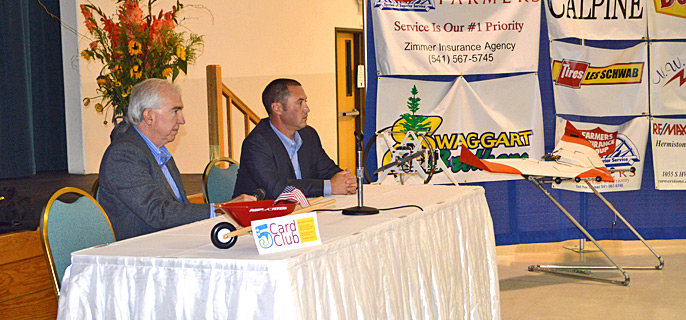
In the not-too-distant future, farmers could have the ability to use images taken from the sky that can pinpoint a single harmful bug on a single leaf of a single plant to help them determine how and when to use pesticides on their crops.
That vision of the future was presented Tuesday afternoon at the Hermiston Chamber of Commerce’s Business to Business luncheon. The panelists for the day were Dan Gadler of the Boeing Company, Josh Brungardt of PARADIGM and Phil Hamm, director of the Hermiston Agriculture Research and Extension Center.
The luncheon crowd was treated to a short video showing a pair of unmanned aerial vehicles (UAVs) (don’t call them drones!) flying no more than 15 feet over crop fields taking a series of images that can assist farmers in the use of precision agriculture.
Those images collected from the UAVs could then provide a wealth of information that could enable farmers to apply very specific amounts of water, pesticides and herbicides in order to maximize crop yields while minimizing any harmful effects to the environment. In other words, the farmer, working with a crop consultant, could then be given a recommended prescription plan for the use of water and chemicals.
The two UAVs shown in the video weigh between six and eight pounds. One of them, dubbed the Unicorn, has fully automated capabilities and can be programmed to fly specific perimeters and altitudes. The other, called Hawkeye, is less sophisticated, equipped with just a propeller and parachute and requires more hands-on flight controls from someone on the ground.

Hamm has hopes that images taken by UAVs could identify what he calls “bad bugs” on a single crop leaf in a 125-acre field. Using a GPS, a farmer could then pinpoint that specific plant and know just what pesticide to use to prevent the bugs from harming the crop, thus preventing yield reduction.
The UAV’s aerial imaging can also show whether a particular crop is healthy simply by its appearance from above.
“When plants are happy, they look differently from plants that are not happy,” Hamm said. “Maybe not to our eyes, but to the eyes of the UAV.”
Gadler said we are still a few years away from utilizing this technology. Several hurdles must be overcome, such as getting authorization from the Federal Aviation Administration for the commercial use of the UAVs.
“The FFA is very, very safety conscious – and rightfully so,” he said. Safety precautions, however, have been programmed into the UAVs, he said. For example, a “virtual fence” is programmed into the computer of the UAV that outlines its flight pattern so that if communication is lost between the on-ground pilot and the vehicle, the computer would direct the UAV to either land or turn back once it reaches the virtual fence.
Production of the UAVs will also have to be ramped up to make them an affordable enterprise. The Unicorn cost about $15,000 to develop, while the Hawkeye cost about $10,000. But the use of UAVs in agriculture will happen, Gadler said. In fact, it is already happening outside the United States in countries that have less stringent aviation regulations.
By the way, it is frowned upon to refer to the UAVs as drones. It turns out that drones are UAVs specifically designed for use by the military.
The public will have the chance to see a UAV in action on Wednesday, June 26 during Potato Field Day at the Hermiston Agricultural Research and Extension Center. For more information on Potato Field Day, call the Extension Center at 567-8321 ext. 101, or visit the center’s website.









